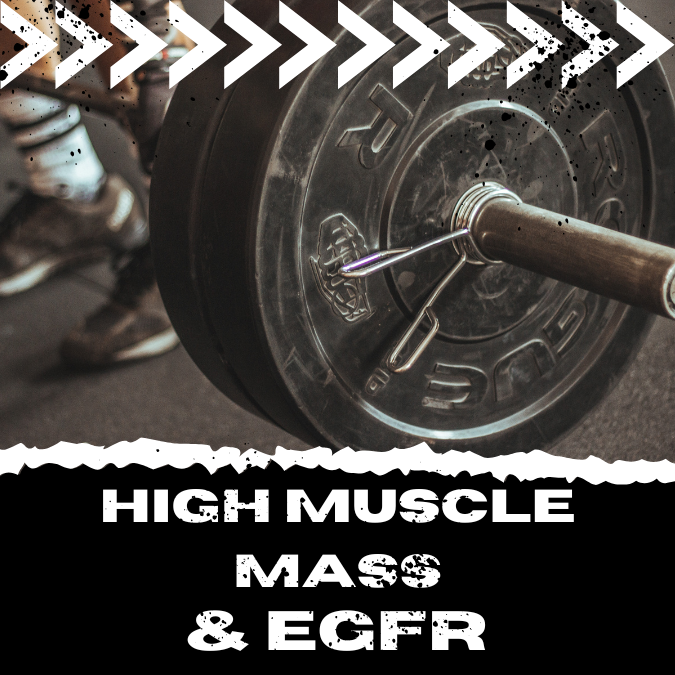This is part of my low eGFR in athletes series. A series of posts focusing on the impact of muscle mass and nutrition recommendations in athletes and how this may impact kidney function.
For people with high muscle mass, interpreting eGFR based on creatinine alone can be challenging. KDIGO 2024 recommendations considering the use of eGFR calculations using both creatinine and cystatin C. But how do these two markers related to muscle mass?
In today’s Journal Club entry, we are trying to figure that out. Today’s article is:
Why understanding muscle mass matters?
Muscle mass is becoming a well known indicator of health outcomes. Studies have reported worse health outcomes when someone has low muscle mass. Therefore, there is clear clinical and scientific utility in tests that can accurately describe someone’s muscle mass.
How can we measure muscle mass?
Several techniques are used to estimate muscle mass, such as:
- DXA scans
- MRIs
- BioImpedance Analysis (BIA)
The Lui et al point out that current techniques tend to require special equipment and are not standards in clinical care. Furthermore, they point out that clinicians would have an easier time screening for early signs of malnutrition or sarcopenia if a routine lab test could be used as a marker of muscle mass.
What lab tests can clinicians use for assessing muscle mass?
The most common lab test that will be influenced by muscle mass is creatinine. The problem though is that this is impacted by kidney health. This means that someone with a high creatinine value could potentially have high muscle mass or kidney disease. And trying to differentiate between the two can be tough.

While the authors of this paper haven’t gone into this, here are some factors I look at to help differentiate:
- BMI – people with low BMI (less than 18) are less likely to have high muscle mass
- Malnutrition/Cachexia – people with visible muscle wasting are unlikely to have high muscle mass
- Athletes – people who routinely engage in muscle building activities, such as athletes may be more likely to have higher muscle mass.
What is creatinine?
Creatinine is the end product of creatine metabolism. In the liver, arginine and glycine synthesize creatine, which becomes actively concentrated in the muscle. The kidney’s filter creatinine and secrete it into the urine.
Various factors increase the generation of creatinine, including:
- Age
- Sex
- Nutritional Status
- Dietary intake of creatine and creatinine
What is cystatin C?
All nucleated cells produce cystatin C. Cystatin C distributes throughout the extracellular fluid. In the kidney, the glomeruli filters cystatin C, and the tubules reabsorbs or degrades most of it, excreting very little in the urine
Various factors increase the generation of cystatin C, including:
- Higher adiposity
- Smoking
- Hyperthyroidism
- Glucocorticoid excess
- Chronic inflammation
- High CRP or tumor necrosis factors
- Low albumin
Notably, many factors that decrease creatinine (e.g., decreased muscle mass) can also increase cystatin C (e.g., inflammation).
Are creatinine and cystatin C markers of muscle mass?
In the review by Liu at al, 67 studies were including that examined creatinine and cystatin C as indexes of muscle mass. 52 of these calculated a creatinine-cystatin C ratio by dividing creatinine/cystatin C * 100 to serve as the muscle mass index.
Studies in the general population have supported that creatinine and cystatin C index are associated with muscle mass, as confirmed by:
- DXA scans
- Handgrip strength
- Mortality
In older adults, studies have also reported associations between muscle mass indexed by creatinine/cystatin C and mortality. This index correlated with muscle mass among those living with cancer when compared to MRI imaging.
Take Aways
- Muscle mass influences serum creatinine values. More muscle mass results in more circulating creatinine. Lower muscle mass results in lower circulating creatinine
- For people living with kidney disease – higher creatinine can also be a sign that the kidneys are not working properly which can make it difficult to differentiate causes of high creatinine
- Muscle mass has a smaller influence on serum cystatin C values. But, factors associated with low muscle mass impact cystatin C. Cystatin C generation will be higher with greater adiposity or inflammation.
- Dividing creatinine by cystatin C generates a value that can serve as an index of muscle mass.
- However, this index has unclear utility for those living with kidney disease because it hasn’t been tested against true, measured GFR.




2 thoughts on “Are creatinine and cystatin C markers of muscle mass?”